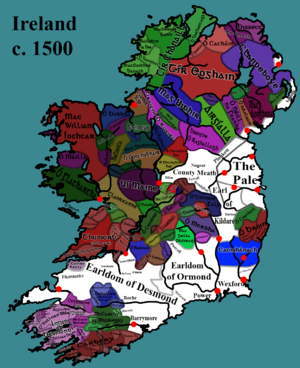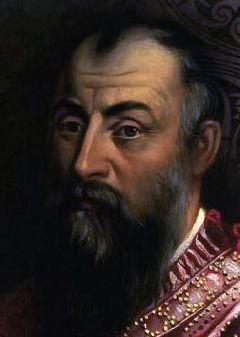Tudor conquest of Ireland facts for kids
Quick facts for kids Tudor conquest of Ireland |
|||||||
|---|---|---|---|---|---|---|---|
| Part of the European wars of religion and the English Reformation | |||||||
|
|||||||
| Belligerents | |||||||
| Gaelic Ireland |
|||||||
| Commanders and leaders | |||||||
FitzGeralds: Spain: |
|||||||
The Tudor conquest of Ireland was a long period when the Tudor dynasty of England tried to take full control of Ireland. This happened during the 16th century. Before this, England only ruled a small part of Ireland called The Pale. Most of the island was controlled by native Irish clans.
After a big rebellion in the 1530s, the English king, Henry VIII, decided to take over all of Ireland. He was even made "King of Ireland" in 1542. The English tried to make Irish leaders follow English laws and customs. They also took land and gave it to settlers from Britain. They made Protestantism the main religion and banned Catholicism.
These changes led to several wars, like the Desmond Rebellions (1569–1583) and the Nine Years' War (1594–1603). Even with help from Spain, the Irish leaders were defeated. By 1603, England controlled all of Ireland. Many Irish leaders left the country in 1607, which led to more land being taken. This land was then given to British settlers, especially in Ulster.
Contents
Ireland Before the Tudors
Around the year 1500, Ireland was a mix of English and Irish control. Back in the 12th century, Anglo-Normans had invaded and taken over many parts of the island. They brought English farmers and workers to live there.
A small area on the east coast, around Dublin, was called The Pale. This was where English language, culture, and laws were strong. It was protected by a ditch and wall.
Outside the Pale, most of Ireland was controlled by Gaelic Irish clans. They had their own language, social rules, and laws. The English government in Dublin had little power over them. In the 14th and 15th centuries, English rule became even weaker. This was due to Irish rebellions, Scottish invasions, and a terrible disease called the Black Death.
Some powerful families, like the Butlers and FitzGeralds, were originally Norman but had adopted Irish ways. They had their own armies and laws. Many areas that were once under English control were taken back by Irish clans. Important clans included the O'Neills in Ulster, the O'Byrnes in Wicklow, and the O'Briens in Clare.
King Henry VIII's Changes
For a long time, English kings let the powerful FitzGerald family of Kildare govern Ireland. This helped keep costs down and protected the Pale. The head of the FitzGerald family was the King's Lord Deputy of Ireland, working from Dublin Castle.
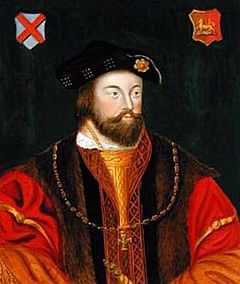
But the FitzGeralds became a problem for the English king. They made deals with other countries and even rebelled in 1534. This rebellion was led by Silken Thomas FitzGerald. At the same time, England was going through the English Reformation, changing from Catholic to Protestant. Thomas FitzGerald, who was Catholic, even offered to give control of Ireland to the Pope.
King Henry VIII stopped the rebellion and executed Silken Thomas. He realized he needed a new plan to control Ireland and protect England's western side.
With help from his advisor, Thomas Cromwell, the King started a new plan called "surrender and regrant". This meant that all Irish lords had to officially give their lands to the King. In return, the King would give the lands back to them with a special document called a Royal Charter. This made them official subjects of the English Crown.
In 1542, the Irish Parliament passed a law that changed the "Lordship of Ireland" into the "Kingdom of Ireland". The goal was to make Irish and Irish-speaking leaders loyal to the English Crown. They were given English titles and allowed to join the Irish Parliament. For example, the O'Neill family was given the title of "Earl of Tyrone". King Henry called his plan "politic drifts and amiable persuasions" (clever ideas and friendly talks).
However, many Irish lords accepted the new titles but continued to rule their lands as they always had. They saw the English King as just another powerful leader, similar to how things worked in the Irish system. Also, Henry's religious changes, though not as big in Ireland as in England, caused some worry.
Challenges to English Rule
After King Henry VIII died, it was hard for the English government to truly control Ireland. Rebellions kept breaking out. One of the first was in the 1550s in Leinster. The O'Moore and O'Connor clans were forced off their lands to make way for new English settlements. These areas were renamed "Queen's County" and "King's County" (now Laois and Offaly).
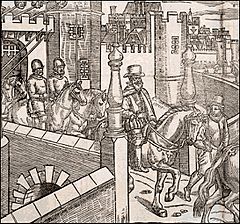
In the 1560s, the English tried to get involved in a fight over who would lead the O'Neill clan. This led to a long war between the English governor and Seán Mac Cuinn Ó Néill. Irish lords also kept fighting each other, ignoring the English laws. For example, the Ormonde and Desmond families fought the Battle of Affane in 1565.
The worst violence happened in Munster from the 1560s to 1580s. The FitzGeralds of Desmond started the Desmond Rebellions to stop England from taking direct control of their land. After a very harsh war, where many people died, the rebellion ended when the Earl of Desmond was killed in 1583.
There were two main reasons for all this fighting. First, English soldiers and officials often acted aggressively. They sometimes killed local leaders or took land illegally. Second, the Irish way of life and laws were very different from English laws. In Irish law, a clan chief was chosen by a group of nobles. But English law said the eldest son would inherit everything. This caused many arguments and fights over who should rule. Also, some groups in Irish society, like mercenary soldiers (called gallowglass) and poets (called file), feared losing their jobs and status under English rule.
English Solutions and More Conflict
Under Queens Mary I and Elizabeth I, the English tried different ways to make Ireland peaceful. One idea was to use military rule in violent areas like the Wicklow Mountains. English troops were placed there under commanders called seneschals. These seneschals could use martial law, meaning they could execute people without a jury trial. This made the Irish chiefs angry.
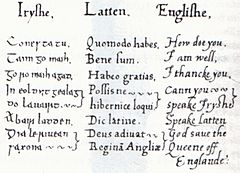
When military rule didn't work, the English tried other long-term plans. One was called composition. This meant getting rid of private armies and putting English troops in charge of provinces. In return, important Irish families were freed from some taxes. But this also led to more violence, especially in Connacht and Munster.
Another big plan was Plantations. This involved bringing people from England to settle in Ireland. These settlers would bring English language and culture and be loyal to the Crown. Plantations started in the 1550s in Laois and Offaly, and later in Munster. However, these early plantations had limited success.
The situation became even more complicated when Pope Pius V declared Queen Elizabeth I a heretic in 1570. This meant that many Irish Catholics believed Elizabeth had no right to rule. Most Irish people remained Catholic, and this declaration gave English officials another reason to push for control. The Second Desmond Rebellion (1579-1583) even got help from papal troops. Religion became a key reason for loyalty or opposition to English rule.
The idea of taking land also made many Irish people angry. This included not only the native Gaelic Irish but also the "Old English" families. These were descendants of the original Anglo-Norman invaders who had lived in Ireland for centuries. They were becoming more and more Catholic, which separated them from the new Protestant English officials and settlers.
The Nine Years' War
The biggest conflict during the English conquest was the Nine Years' War. This started when English officials tried to take control of Ulster, a region in the north. Ulster was home to Aodh Mór Ó Néill, the most powerful Irish lord.
At first, Ó Néill seemed to support the English. But secretly, he helped other Irish lords fight the English in nearby areas. This kept the English army busy while Ó Néill built up his power in Ulster. In 1595, Ó Néill openly rebelled by destroying an English fort.
The war spread across Ireland, especially after Spain promised to help the Irish in 1596. What started as a fight for local control became a war for all of Ireland. The Irish won a big battle at the Battle of the Yellow Ford. The English settlements in Munster also collapsed. It looked like English rule in Ireland might end.
The Nine Years' War was also part of a larger conflict between England and Spain. In 1601, Philip III of Spain sent an army to help the Irish. But the Spanish forces surrendered after a siege at the Battle of Kinsale. Ó Néill's army was also defeated outside Kinsale.
The war ended in early 1603. English control was slowly brought back across the country. Ó Néill and his allies were treated fairly well at first. They got their titles and most of their lands back. But they found it hard to live under the new, stricter English rules. In 1607, Ó Néill and other leaders left Ireland in what is known as the Flight of the Earls. Because they left, their lands in Ulster were taken by the Crown. This led to the Plantation of Ulster, where many British settlers moved to the north of Ireland.
As more land was taken for plantations, English control became more military-focused. The Counter-Reformation (the Catholic Church's response to Protestantism) made many Irish people strongly anti-Protestant. This made it harder for England to influence them. It became clear that the main benefit for England from controlling Ireland was the land itself. Thousands of Protestants, especially from Scotland, moved to Ulster, replacing the Irish residents.
Outcomes of the Conquest
The most important result of the Tudor conquest was that the native Irish lords lost their power. For the first time, the English government had control over the entire island. Irish culture, laws, and language were replaced by English ones. Many Irish lords lost their lands and their traditional authority.
Thousands of settlers from England, Scotland, and Wales were brought to Ireland. Justice was now carried out using English common law and laws passed by the Parliament of Ireland.
As the 16th century went on, religion became a huge issue. Irish rebels like James Fitzmaurice Fitzgerald and Aodh Mór Ó Néill asked for help from Catholic countries in Europe. They said they were fighting for their religion.
In the new century, Ireland became divided between Catholics and Protestants. This was especially true after many English Protestants and Scottish Presbyterians settled in Ulster.
Under King James I, Catholics were not allowed to hold public office after a plot against the king was discovered in 1605. The native Irish (both Gaelic and Old English) increasingly saw themselves as Catholic, in opposition to the Protestant "New English" settlers.
However, the native Irish still owned most of the land until after the Irish Rebellion of 1641. By the 1650s, after the Cromwellian conquest of Ireland, the "New English" Protestants controlled most of the country. Their descendants later formed the powerful group known as the Protestant Ascendancy.
See also
- History of Ireland (1536–1691)
- Plantations of Ireland
- History of Ireland
- Desmond Rebellions
- Nine Years' War
- Miler Magrath
|


